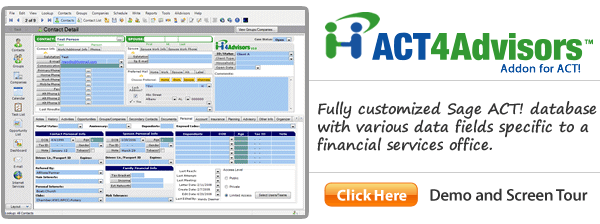

The User would need to JOIN the two Views appropriately to compose the query required to product a report of Notes by Contact, for example. The following highlights an example of the difference using the Contact and Note building-block records (Entities): Version 1.0: The Contact Notes View, named VRP_CONTACT_NOTE, contains all of the Note columns and just the Primary Key column for the Contact record (CONTACTID), not the Contact columns themselves. These Views reside atop of underlying table Functions which contain the RLS and FLS security enforcements. With both versions, the ACT! virtual columns (Address, and Phone) are flattened as the JOINS required to obtain those columns are already included in the base table View clause. These Views are modeled in a buildingblocks approach, which actually differs somewhat between version 1.0 and version 2.0. These essentially look similar to database Tables, however, these Views contain relevant ACT! implementation details such as Security and other rules. The fundamental design approach of the OLE DB Provider is to expose Tables as database Views. The User provides an ACT!.PAD file and user/password credentials for its connection/data source, then creates a physical connection to the database using a specific standard SQL Server login account. The Provider is a communication library written in C++ that is essentially a pass-thru layer to 1 In ACT! Premium for Web, administrative functions must be performed on the Web server ACT! Reporting and Data Access 3Ĥ communicate with the underlying SQL Server OLE DB data provider. The data returned is provided in a read-only manner and within the same security context as the ACT! application, respecting both Record-Level Security (RLS) of the data and Field-Level Security (FLS) of the schema.
#Act by sage 2013 software#
The primary objective and use-case is for external reporting of ACT! data via third-party software such as Crystal Reports and Excel. Background and Specification: The version 1.0 Provider was created with the original development of ACT! 2005 (7.0). There are two OLE DB Providers offered by ACT!, referred to as version 1.0 and 2.0. The Provider is the desired method for querying the ACT! database both from within the application, as well as externally. The Provider is designed to leverage the underlying client-server platform and the power of the Microsoft SQL Server relational database engine which services the ACT! database. OLE DB Reporting Provider The ACT! OLE DB Reporting Provider is a data source provider written by Sage and is included with ACT!, ACT! Premium and ACT! Corporate Edition (includes ACT! Premium and ACT! Premium for Web). The four Data Access Methods each offer a very different approach and data exposure. Such a case might include the need to perform unconstrained data rollups to a company or corporate level for consolidated reporting or other analytics. Depending upon the task, data security may or may not be of concern. Data Access Overview While the ACT! Report Designer offers a fairly comprehensive ability of creating custom reports and other correspondence, it can be limited in some aspects.

This includes data extraction to consolidated databases for rollup, as well as highly-customized reports using thirdparty software such as Crystal Reports.
#Act by sage 2013 password#
These methods can be used for querying, reporting and data extraction: ACT! OLE DB Reporting Provider ACT! Reader Utility and account (ACT! Premium only) ACT! Password Utility (ACT! Premium only) ACT! SDK (Software Developers Kit) The objective of providing these additional methods outside of the ACT! application is to offer the user the most flexibility in creating reports, lists or other documents to suit most any need.

In addition to Report Templates, the ACT! architecture provides four additional Data Access Methods. Template customization 1 is performed by the user right from within the application using the ACT! Report Designer. These items are based upon templates which can be further modified or copied to create a customized and specific solution as needed. v2.0 Comparison ACT! Reporting and Data Access 2ģ Introduction The ACT! application provides its own Report Writer that offers a number of stock Reports, Envelopes and Labels which allow users to produce a variety of reports and correspondence. 8 ACT! Password ACT! Software Developers Kit CONCLUSION Recommendations Data Access Method Comparison Terms and Concepts OLE DB v1.0 vs. 1 Whitepaper Reporting and Data Access Methods ACT! by Sage Product FamilyĢ Table of Contents Introduction.


 0 kommentar(er)
0 kommentar(er)
